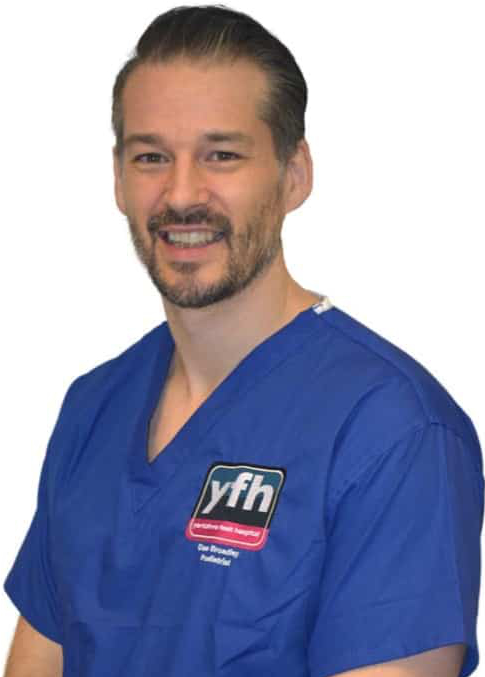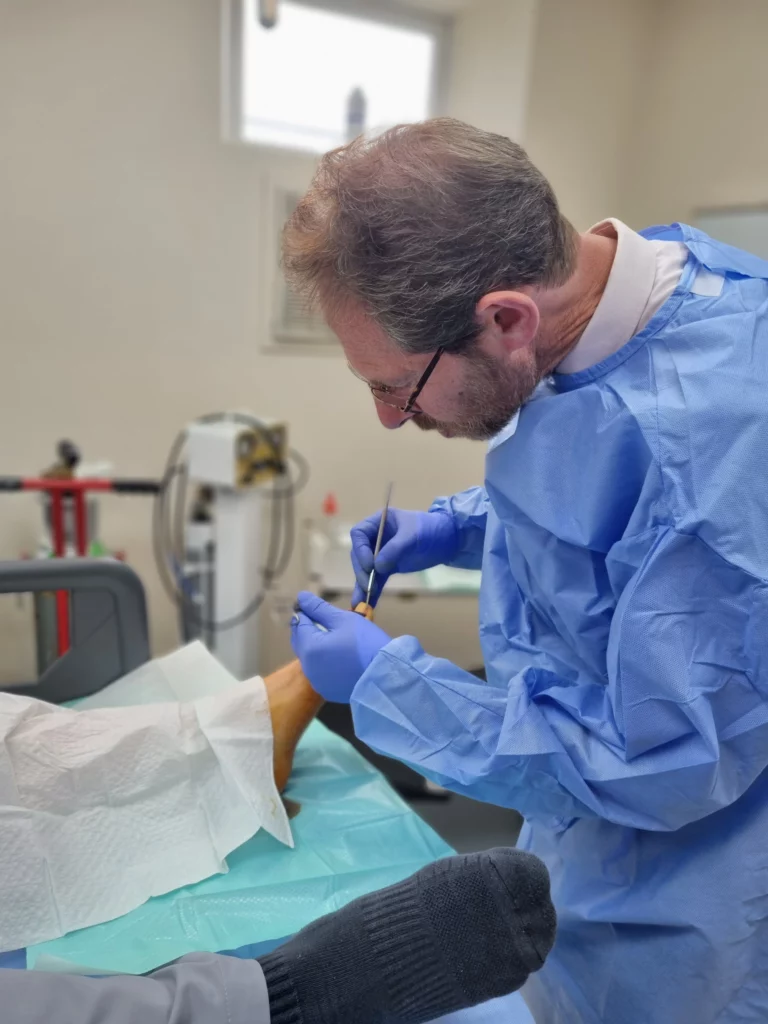The Yorkshire Foot Hospital and Podiatry Centre at The Lawrence Clinic for the treatment of…
Podiatric Surgery
The Yorkshire Foot Hospital and Podiatry Centre, an acute Podiatric Surgery day case unit, has now opened within The Lawrence Clinic in Leeds, specialising in both the diagnosis and treatment of foot and ankle disorders. While many foot problems respond well to non-surgical treatments, others may require surgical intervention.


Steve Finney
Consultant Podiatric Surgeon


Tony Wilkinson
Consultant Podiatric Surgeon


Dan Broadly
Extended Scope Podiatrist


Jonathan Stanley
Musculoskeletal Podiatrist
Podiatric Surgery can be defined as the surgical treatment and management of the foot and its associated structures and is particularly effective for persistently painful conditions or where the foot is being affected by deformity.




The hospital is led by Consultant Podiatric Surgeons who hold substantive NHS posts and are Surgical Fellows of the Society of Chiropodists and Podiatrists, governed by the Health Professions Council (HPC) and whom have been providing foot surgery services in Leeds since 1997.
The YFHPC is proud of its established reputation for the delivery of high quality patient care to meet with your individual needs within the field of Podiatric Surgery and aimed at reducing pain and discomfort to restore foot function.
From initial consultation to final discharge, each patient is always given the opportunity to extensively discuss their proposed treatment plan with their Consultant Podiatric Surgeons supported by a highly qualified team of experienced Musculoskeletal Podiatrists, Theatre and Nursing staff backed by a 24 hour on-call team.
About Podiatric Surgery
Following a three year BSc degree training in Podiatric Medicine, all Podiatric Surgeons undergo
a minimum of six years post graduate training with a three year surgical residency at an approved
NHS training Hospital prior to qualification as a Consultant Podiatric Surgeon.
Mr Tony Wilkinson and Mr Stephen Finney currently undertakes 600-650 foot surgery cases a year ranging from Bunions, Hammer toes to more complex surgery mainly under local anaesthetic on a day case basis, and is a Fellow of the College of Podiatric Surgeons and registered under the regulatory body, The Health Professionals Council UK (HPC).
How is Surgery undertaken?
The vast majority of Podiatric Surgery is undertaken on a day case basis under local anaesthetic, which is both safe and allows very good post-operative pain control, avoiding sickness and nausea which is sometimes encountered following general anaesthesia and allowing patients to be discharged home.


Should a patient prefer a general anaesthetic or local anaesthetic with sedation, this can be arranged to be carried out by a Consultant anaesthetist which may in some circumstances require an overnight stay in hospital. Most operations to the forefoot at The Yorkshire Foot Hospital take less than one hour, the complete surgical experience usually requires the patient to be in the hospital for two to three hours before being discharged home.
Patients are able to choose their surgical dates at their convenience with appointments available on evenings and at weekends.
Post-Operative Care
Adequate follow-up care is essential, patients are normally seen at one and two weeks, three months and a final review at six months, all patients prior to their procedure are prescribed adequate analgesia for their first five days after surgery, following which this can generally be discontinued.
Should patients be concerned or experience any post-operative problems, we provide a 24 hour on – call service, and if required home visits will be arranged.
Podiatric Surgery and the Arthritic Foot
Undertaking surgery to the arthritic foot is a challenge and often dependent upon the type of arthritis, its severity and the degree of joint damage, particularly to the articular cartilage of the joint which is responsible for its smooth, pain free motion, arthritis generally destroys this cartilage given time.
The principle aim of the surgeon is to wherever possible reconstruct the joint and slow down the progression of the disease along with medication provided by the patient’s physician, however this is not always possible especially after prolonged arthritic change so surgical procedures are generally split between correcting joints which show early to moderate disease and late severe degeneration.
Surgical procedures used in early disease might include simply removing inflamed soft tissue (synovial pannus) from around the joint as this is responsible for the destruction of the vital articular cartilage, the swelling and pain patients experience, more often though this will be combined with the removal of arthritic bone from the joint margins (Cheilectomy), this should restore pain, free movement to the joint and delay progression of the disease.
More serious degeneration of the joint may show as a Bunion deformity, hammer toes and prominence of the heads of the toes under the foot, these deformities often make footwear difficult to obtain and predispose the patient to recurrent ulceration and infection.


Arrow shows loss of the joint space with bony spurs (osteophytes) around the joint.
In these cases surgical correction requires a more aggressive approach with bones being cut and repositioned to decrease the pressure they receive, while at the same time this should improve function of the joint, reduce pain and deformity, ease footwear problems and improve mobility.
These procedures are called osteotomies, the bone being held together until healed by tiny screws, threaded wires and metal plates which generally stay in place forever unless they cause a problem at which point they can be removed after 6 – 10 weeks, most patients need NOT be placed in plaster casts and begin to walk after 2 weeks rest at home.
In those patients with longstanding severe joint destruction and deformity, the surgical reconstruction is not generally an option, the aim is to reduce pain by the removal of the bony deformity often in an effort to eliminate recurrent ulceration despite adequate footwear.
Generally with inflammatory disease all the metatarsophalangeal joints (the balls of your feet) will be affected especially the lesser toe joints and destruction severe, bone quality is poor and the procedure of choice is to simply remove one, but more often all of the joints to create a slightly shorter foot and remove pain under foot.
The big toe joint is fused together in a position that will allow the patient to walk pain free and with markedly increased stability, this type of fusion is called an arthrodesis and can be applied to toes to deal with clawed and hammered toes which have become fixed and irritated by footwear.




Toes which are still flexible to a degree can sometimes benefit from arthroplasties, where the Podiatric surgeon removes a small piece of arthritic bone from the joint, the body heals the area by laying down fibrous tissue which creates a false fibrous joint still capable of some movement, although never as good as a normal joint, it functions reasonably well and can always be fused at a later date if required.
A developing area of joint replacement especially in those patients who have good bone density and alignment is by using implants specifically designed for the foot and made of ceramic materials, although they have yet to be fully evaluated long term, and should offer improvement over silicone implants which are better suited to the hand, overall joint reconstruction should be attempted first before implants are considered.
Podiatric Surgery has now become more available to patients and offers another modality of treatment against arthritic diseases affecting the foot.
The Lawrence Clinic, boasts a fully-equipped Operating Theatre Suite and X-ray department registered with The Healthcare Commission dedicated to patients who may require Foot Surgery.
The Department prides itself in providing both Outpatient Clinics and day case foot surgery, The team is lead by Mr. Tony Wilkinson and Mr.Steven Finney and a team of Podiatrists, surgical trainees and nursing staff who specialise in the treatment of arthritic disease of the foot.
Range of Podiatric Surgical procedures undertaken at The Lawrence Clinic include:
- Forefoot reconstruction surgery
- Bunion Surgery
- Hallux rigidus
- Hammer/claw toe surgery
- Neuromata / ganglions
- Achilles tendon lengthening
- Superficial soft tissue surgery
- Ingrowing Toenails
Advantages of Day case Foot Surgery at The Lawrence Clinic
- Surgery undertaken under local anaesthesia
- Reduces need to stay in hospital
- Minimizes patient anxiety
- Patients can return back to work and sport quicker
- Most patients don’t require foot casting
For those patients who do not require surgery, the Podiatry Department at The Lawrence Clinic provides prescriptive, casted Orthotics (surgical foot appliances) prior to Biomechanical examinations, measurements and Video-gait analysis.
Spread the cost of your treatment with Chrysalis Finance
Click here to get in touch or Call 0113 2900 310 to book your appointment now.

